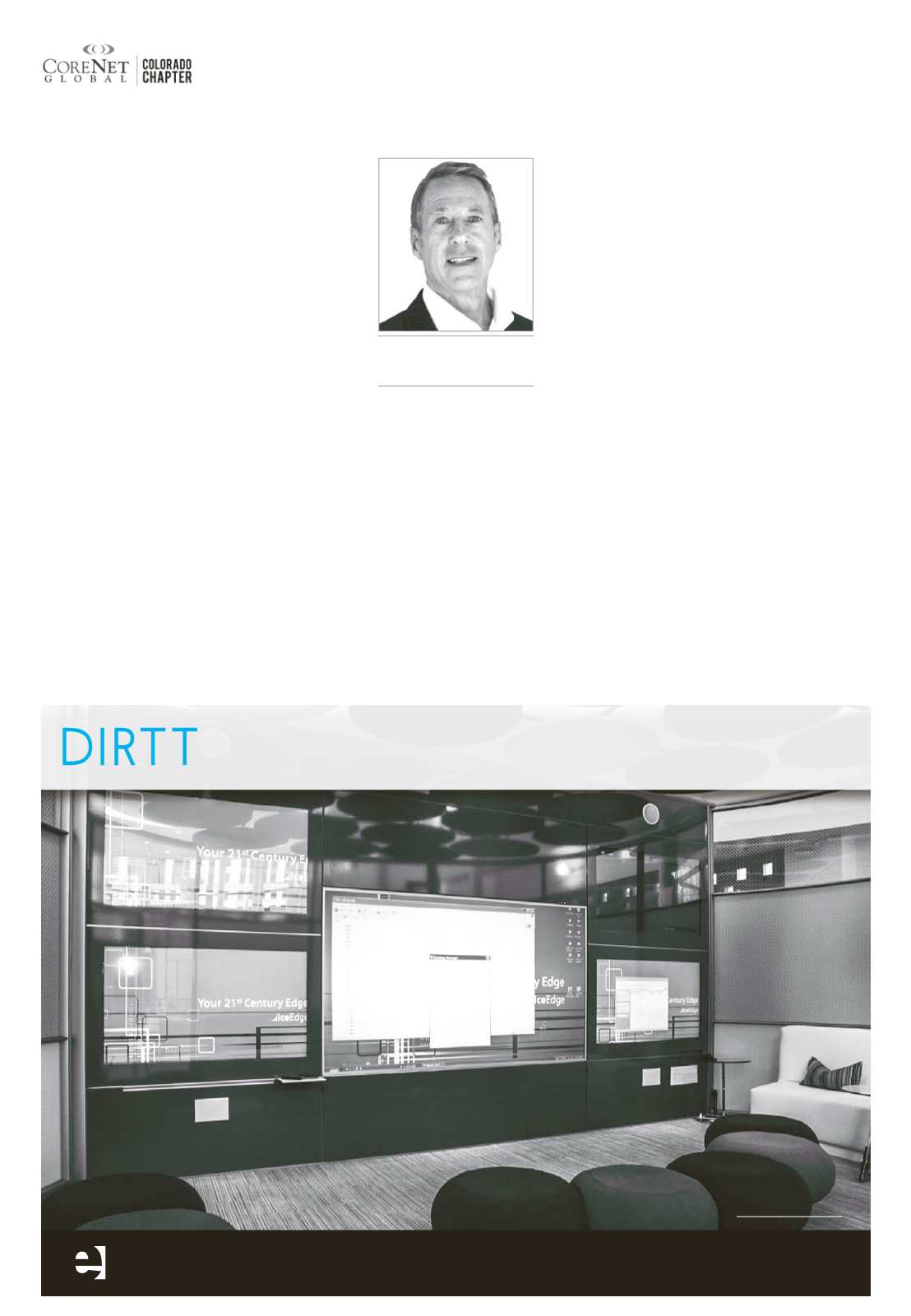
Page 6AA —
COLORADO REAL ESTATE JOURNAL
— November 19-December 2, 2014
E L E M E N T S
303.471.4334 | 2501 Blake St. Denver, CO 80205
Prefabricated DIRTT Walls
incorporating embedded displays and more
DIRTT
Integrated Technology
Spotlight
T
oday, most companies
are trying to deal
with two big issues in
the workplace, 1) the change
in technology and 2) how
it relates to attracting and
retaining the best human
capital. As a 25-plus-year
veteran in the workplace
industry, I have found
addressing these ever-growing
concerns with my clients to be
important because they are
synonymous. If a company is
unable to adapt to changing
technology they won’t be able
to recruit the best talent in the
future: the life blood of most
organizations.
Obviously, the war for
talent (finding and retaining
top talent) has been around
for over 20 years and never
has it been more prevalent
than today. In the past,
demographics played a big
role in the rise and fall of
the labor force. From 1960
to 2000, labor surged from
59 percent to a peak of 67.3
percent largely due to more
women entering the labor
market, but also improvements
in health and the fact that the
types of jobs available allowed
Americans to work more years.
However, since 2000, the labor
force rate has steadily been
declining as the baby boom
generation began retiring with
fewer eligible workers available
to replace them. In fact, it is
estimated that the labor force
participation will be even lower
in 2020 regardless of how well
the economy is performing.
With this decrease in
potential labor force,
companies recognize the
importance of understanding
what drives their workforce
and the need to strategically
build a better workplace
culture that not only will
inspire their current staff but
also attract future top talented
employees. Additionally,
companies are integrating
the individual needs of a
multigenerational workforce as
a means of their own survival.
In fact, it won’t be long
before the next generation of
workers (currently in junior
high), adept in all things
technological from smart
phones to social media, will be
in the workforce mix.
Attracting a talented
workforce and building a
better workplace culture boils
down to the workspace and the
life-work balance offered by an
employer.
n
Workspace.
How does our
physical workspace need to
function to accommodate not
only technology but also attract
and retain the best human
capital? Today’s top talent
has no interest in working in
stagnate work environments.
They long to feel valued
and thrive in collaborative
environments with a balance
of teaming, learning, private
space and mobility. They tend
to be workers with intense
ambition, and employers must
take note that they are always
on the lookout for greener
pastures. Pleasing top talent
with workspaces that provide
openness, yet are acoustically
tuned and ergonomically
inviting will be the norm versus
the exception.
Incidentally, companies may
be hiring and retain teams not
just individuals. These groups
of individuals are used to
working together. They know
each other’s strengths and can
focus jointly on a particular
project, increase productivity
while reducing downtime,
and share knowledge instantly
and in virtual fashions. Teams
such as these will need to be
supported by collaborative
work environments that are
not tied to a past technology,
but flexible and adaptable
to advancing operations and
processes.
Employers are keenly
aware that to modify the
workspace to accommodate
new technology or products
places high demands on
the quality of the furniture
supporting these changes.
Companies will find a flexible
kit of parts crucial to the
adaptation of these workspace
changes with focus assuredly
on productivity, which also
includes ergonomics, self-
space adjusted work areas, and
personal boundary acoustics.
n
Life-Work Balance.
To
further the “win for talent,”
companies may need to
address how they shape a
positive work-life balance as
a means of attracting and
retaining the best talent.
Future workers will gravitate
to companies that allow a
sense of control over visual
access, social media forms
of communication, and
knowledge. Many will look
even closer at “best places
to work” as a factor in their
decision to secure a future
job with an employer. With
employees working “on the
job” even when they are not
“in the office,” employers
providing mobile flexibility
will encourage productivity,
while aiding individual life
responsibilities outside of work.
Reducing stress through
environmental measures
can also be a key objective
assimilated into the workspace.
Some studies suggest that
an employee’s memory and
learning are directly related to
the context of their physical
space. Thus blending areas in
the works space that relieve
tension may also encourage a
more stress-free atmosphere
and stronger life-balance
support (e.g., fitness room,
lounge or other casual
meeting areas, entertainment/
recreation room, etc.).
One thing is for certain,
in the future the physical
workspace, how it is designed,
its ease of configurability,
adaptability to change, and
its support of advancing
technology will play a
crucial role in attracting
and retaining top talent.
Essentially, companies will
have to consider the human
factor when moving forward
and creating a working
environment that reinforces
these values. The end result is
that instead of working for you,
these top talent individuals will
be working with you: building
enormous buy-in and a better
workplace culture.
Mike Starita
Business Development, ELEMENTS


